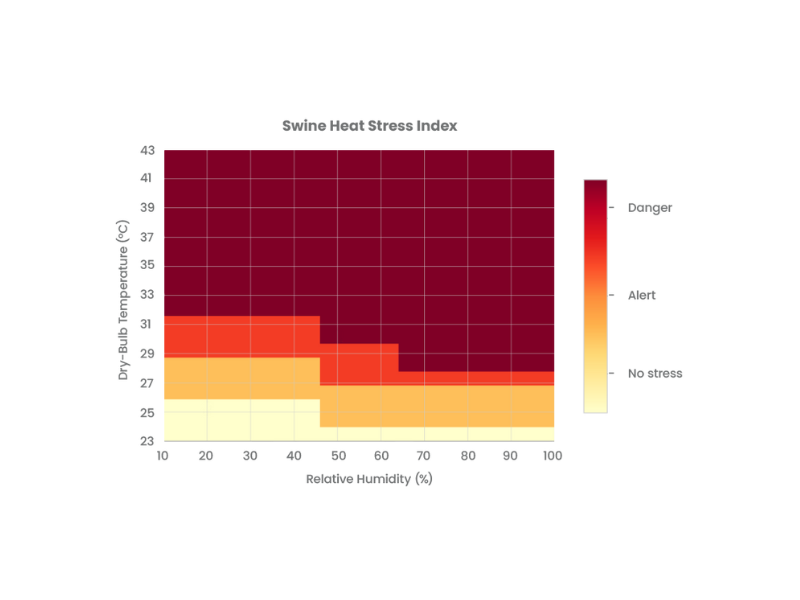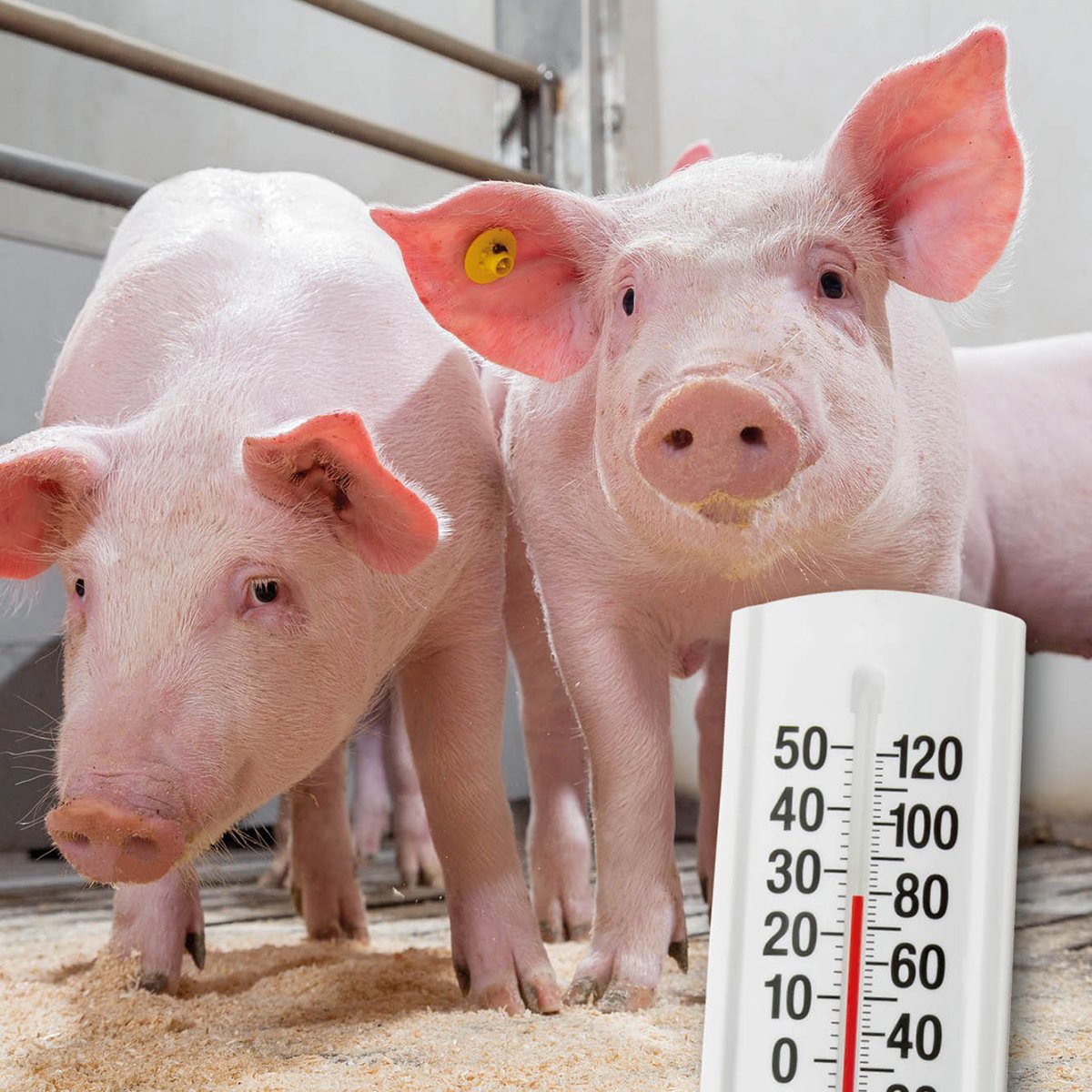Combating heat stress in pigs
Heat stress is a growing concern in pig production worldwide due to rising temperatures and humidity levels – it is estimated to cost agriculture $200 billion annually. Implementing effective environmental, nutritional, and management strategies can help reduce its impact on pig health, performance, and productivity. Studies show that as little as 2-6 hours of heat stress can compromise gut health, allowing harmful bacteria to invade the body more easily.
Farmers may experience losses in terms of:
↓ milk production
↑ mortality
↑ abortion rate
↓ market weight

When does heat stress occur?
Pigs are highly susceptible to heat stress, and both temperature and humidity play a critical role in determining its severity. When exposed to high temperatures, pigs struggle to regulate their body heat, leading to reduced feed intake, increased respiration rates, and even serious health risks.
- Grower-finisher pigs start experiencing heat stress at around 28°C when humidity is low (30%), but at higher humidity levels, even lower temperatures can cause issues.
- Larger pigs (75kg and above) are more vulnerable, with performance declining at temperatures above 23°C.
- Breeding herds have even lower tolerance, making sows and boars particularly at risk.
The Swine Heat Stress Index provides a useful guide to assessing heat stress risk levels. When temperatures exceed 28°C with moderate humidity, intestinal health and growth performance are significantly affected. As conditions worsen, pigs move from alert zones to danger zones, where immediate action is required to prevent severe health impacts or mortality.
Impact of heat stress on production and animal welfare
Pigs are particularly vulnerable to heat stress because they do not sweat efficiently and have limited ability to regulate their body temperature. Heat stress occurs when pigs are exposed to temperatures above their comfort zone (typically 16-18°C for sows and finishers). This can lead to:
- Reduced feed intake: weight loss, slower growth rates, and lower feed efficiency.
- Increased respiration: dehydration and metabolic disruptions.
- Weakened immune function: higher disease susceptibility.
- Reproductive issues: lower fertility, smaller litter sizes, abortions, and poor semen quality.
- Behavioral changes: distress, restlessness, and aggression.
- Increased mortality: especially in young, stressed, or immunocompromised pigs.

Managing and preventing heat stress in pigs
Environmental strategies:
- Cooling systems: Ensure that sows have access to cool environments. This can include fans, misters, or evaporative cooling systems to lower ambient temperature.
- Adequate ventilation: Proper airflow and ventilation in housing can help reduce heat accumulation and keep sows cool. These should be checked regularly for optimal conditions.
- Comfortable housing: Reducing direct sunlight exposure minimizes heat buildup. Slatted floors and well-designed spaces also help pigs
Water strategies:
- Provide clean, fresh, and cool drinking water at all times.
- Check and clean drinking nipples regularly to maintain proper flow rates.
- Lactating sows require up to 50 liters of water per day to sustain milk production.
Feeding strategies:
- Adjusting feeding times: Feed sows during cooler hours (morning/evening); this can help increase feed intake, as sows are more likely to eat during cooler times.
- Monitoring heat stress indicators: Monitor sows for signs of heat stress, such as excessive panting, restlessness, and reduced feed intake. Early intervention can prevent more severe consequences.
Nutritional strategies:
Feeding swine during heat stress requires adjustments to ensure their nutritional needs are met while also reducing the impact of heat on their feeding behavior and overall health. Swine, especially during periods of heat stress, may eat less, so providing the right kind of feed and management practices is key to maintaining their productivity and welfare.
- Increase fat content: Fat provides more energy per unit than carbohydrates or proteins. Incorporating higher levels of fat (such as vegetable oil or animal fats) into the diet can help meet energy needs without increasing the heat load from digestion. This is because fat requires less energy to digest than carbohydrates and proteins.
- Reduce fiber content: High fiber diets require more energy for digestion, which can increase heat production. Reduce the fiber content in the diet to minimize the digestive energy required and thus reduce heat production during digestion.
- Provide more frequent, smaller meals: Pigs eat less during heat stress, so providing smaller meals more frequently throughout the day can help ensure they are getting the nutrients they need without overwhelming their digestive system. This can also help prevent digestive upset.
- Ensure sufficient starter feed for piglets, as sows produce less milk in hot conditions.
- Give supplementations:
- Electrolytes: help maintain hydration and replenish the salts lost through increased sweating and respiration. Increased water demand leads to an electrolyte imbalance, affecting animal performance. Supplementing diets with sodium bicarbonate can help maintain proper acid-base balance and alleviate respiratory alkalosis caused by heat exposure.
- Cooling agents: minerals and vitamins (especially B-vitamins) help maintain appetite and feed intake to support physiological resilience to heat stress.
- Antioxidants – Help combat oxidative stress caused by high temperatures.
Antioxidants reducing heat stress
Heat stress increases oxidative stress in pigs, leading to the production of reactive oxygen species (ROS) or free radicals. These molecules can cause damage to cell membranes, proteins, and DNA. Antioxidants play a significant role in mitigating these effects by neutralizing free radicals, supporting immune function, and improving gut health.
Oxidative stress reduction
When blood flow shifts to peripheral tissues during heat stress, internal organs, including the intestines suffer from oxidative stress. Feeding antioxidants and osmolytes can mitigate this problem. However, antioxidant sources must have a strong potential to neutralize the free radicals that cause oxidative stress. Vitamin E is typically used in animal diets during heat stress but has relatively little effect and works only in a lipid medium. Polyphenols are considered natural substances able to induce strong effects against free radicals generated in the GIT and throughout the body during heat stress conditions. The most effective polyphenols have higher bioavailability and are active in both lipid and water-based tissues. (Trouw Nutrition developed AO-mix, a feed solution comprised of highly bio-available polyphenols with potent antioxidative properties.)
Immune function support
Heat stress weakens the immune system, making pigs more susceptible to infections and diseases. Antioxidants, particularly vitamins A, C, and E, play key roles in supporting the immune system and reducing inflammation, thereby improving the pig's ability to fight off pathogens.
Gut health protection
Heat stress diverts blood from internal organs to the skin, compromising gut integrity and nutrient absorption. This can lead to a higher risk of pathogens entering the bloodstream and causing illness. High bioavailability polyphenols can help maintain gut integrity and function during heat stress conditions.
